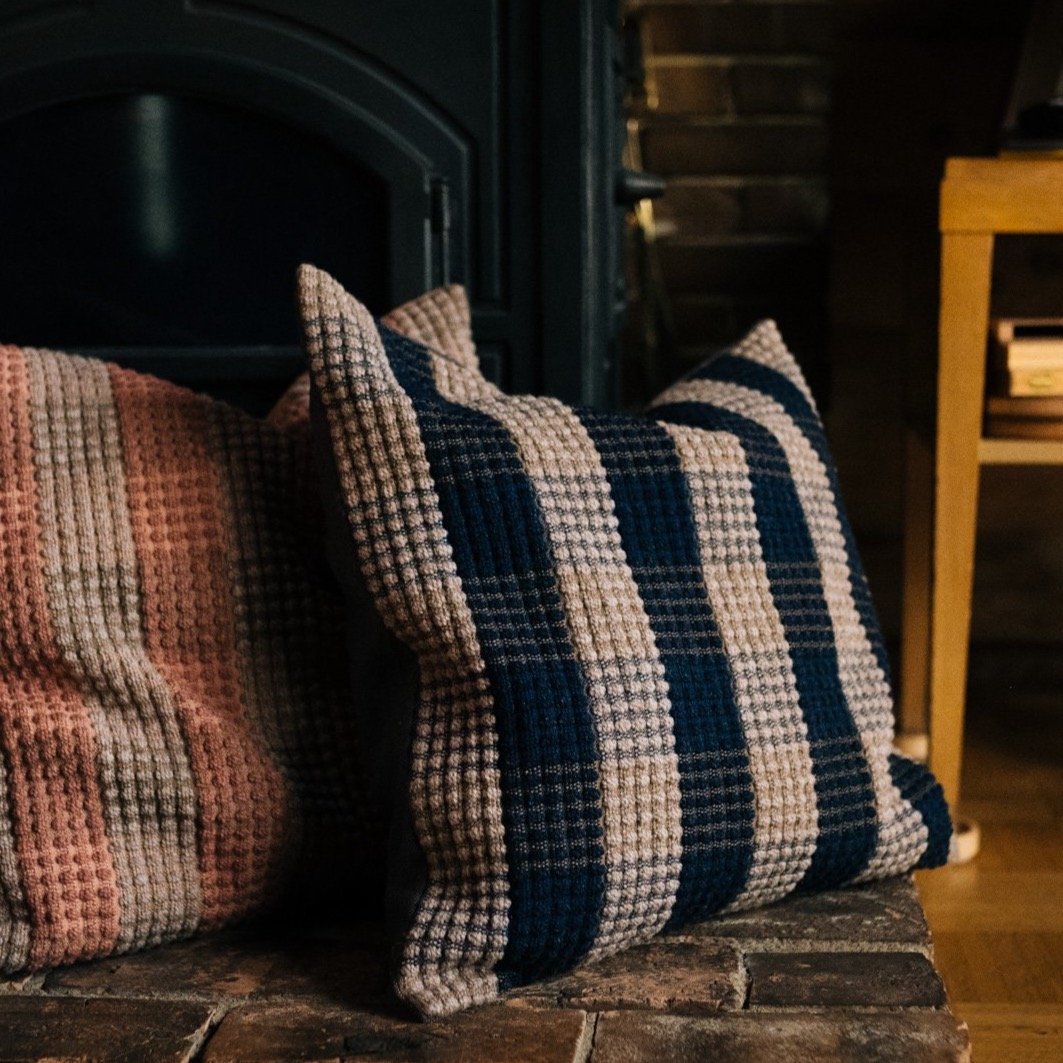Our new Campfire collection features designs from many Canadian weaving designers, including Amanda Rataj. Amanda is a working artist and weaver whose explorations of weave structure are a joy to follow. We chatted with Amanda about learning new things, touching everything, and her Pebble Pillow Cover pattern and kit.
Gather: Scrolling through your instagram I see plain weave, twill, overshot, float work, crackle, lace weaves, adventurous weft materials… with so many structures to play with, what ties your work together (besides the colour blue)?
Amanda: I don’t think that I have one thing that I focus on — my work is more an exploration of different textures, shapes, and ideas, all of which can (maybe) be expressed using different structures.
I’m a very materialistic person in the sense that I love material and texture — I like to touch. When I went to art school I majored in photography, but I was also doing a lot of papermaking and then combining the two to make very tactile, material-based artworks — things that benefitted from real-life experience. But a photograph is not something that you should touch or handle in the same way you can a kitchen towel or scarf —they’re precious, meant to be looked at and generally placed on the wall.
Textiles are a way for me to creatively work through my thoughts and ideas in a medium that can be physically engaged with and experienced — I’m not precious with my work (well, some of it I am…!) and I don’t think that it really comes into its full meaning until it’s used.
This usefulness and material experience is what draws me to making craft objects. Like a scientist might, I think of trying many different techniques as a sort of experimentation or exploration — how can they inform my current and future thinking?
One undercurrent I’m always thinking of is the environmental impact of my practice and work — I don’t consume much that’s new and I try to be mindful in what I’m making and the materials I’m using. In the past I’ve worked with Taproot Fibre Labs out in Nova Scotia and used their Canadian grown and spun linen. I like working with Briggs and Little (which I used in my Gather cushion!), and I’ve recently had three cones of wool yarn spun from a local farmer I know (thanks Albus the sheep!).
Gather: You’re also someone who is always learning! What are your favourite ways of learning more about weaving?
Amanda: I’m a self-taught weaver. My mum is a weaver and I learned initially from her, but then I did a lot of solo learning. I spend a lot of time figuring things out for myself, and can have quite a perfectionist streak that is sometimes good and sometimes not as good. I’m a very visual learner — I like to see and then do.
I learn more about weaving by exploring different structures, making samples, and trying new things. If there’s something specific I want to learn and need assistance, I’ll ask very patient and generous friends who might know the answer, scour books and the internet, or just give it a go. I like to make lots of samples (it’s like sketching!) so I usually start there and then scale up to the size I have in mind. Sometimes things don’t work out the way I expect, so I put them away and then come back to them later — my second loom has become a bit of a hanger for some of those percolating projects…
I have a lot of interests (some that stick around longer than others), and I read a lot of fiction and non-fiction books. These interests almost never have to do with weaving but always end up informing what I do in some way or another. Because I can, here is a mixed-bag reading list for other book-worms out there:
Having and Being Had, by Eula Biss
Two Trees Make a Forest, by Jessica J. Lee
The Fifth Season, by N.K. Jemison
How to Do Nothing, by Jenny Odell
Mr Loverman, by Bernardine Evaristo
Gather: It seems like supporting new weavers is a big part of what you do, from working in a yarn shop to making patterns to teaching classes. What draws you to teaching?
Amanda: I feel very strongly that it’s important to support each other, so I intentionally make the time and space to do so. I feel doubt in my work and envy and longing just like other people, but I find the best antidote is to celebrate other people’s successes as though they were my own. I’ve not always been great at it but I think we’re all better off if we help each other get to where we want to go instead of being protective or competitive with each other. There’s lots of room for everyone’s approach and work!
When it comes to teaching, I think I enjoy most the opportunity for exchange. For the last decade I’ve worked at the Art Gallery of Ontario facilitating conversations about art and learning as an educator in their adult and school programs, and what I do there has spilled over into all areas of my life. It sounds selfish, but I get to learn by helping other people learn, so it’s very motivating and pleasing. It’s a good way to exchange knowledge and see things from other peoples’ perspective. The same goes for working at a yarn shop — is there anything nicer than helping someone realize a creative idea??
There’s always something to learn, even if it’s just figuring out how to communicate something in a way which makes sense to someone else. There’s a lot of things that my hands know that is very challenging to describe in words, and I love trying to pass on those types of skills.
There’s a lot of problem solving in teaching, too. I think lot of creative people are very good problem solvers. We’re used to approaching something with a different tack, whether it’s an art project or something that needs to be fixed in your own home. Teaching and weaving both get that problem solving part of my brain going in a good way.
Gather: How did you bring that spirit of creative problem solving to Gather’s Campfire collection? Can you talk a bit about the pillow cover you’ve designed?
Amanda: One of my (many) interests for the past few years has been circles and how you can make them on the square grid of weaving. The cushion cover I have designed is one way that I’ve recently been exploring this interest. I like to sample a lot and have bags and bags of little woven pieces; for this project, I made three small samples plus two full-sized pillows where I used different materials in both the warp and weft, scaling it up and down to find a surface that I liked.
Gather: What sold you on the final design?
Amanda: In the Campfire collection mood board, there were a lot of images of plaids and checks — I wanted to see how I could incorporate checks (which I love!) in a more subtle way.

I think that I generally weave a lot of flat things, so I also wanted to try making a woven surface with more texture. The final surface is similar to knitted bobbles or rounded pebbles — and so far it’s a big hit at my house, my boyfriend loves it!
While I was thinking through this project, I had a commission to make something for my friend Deborah. She invites us to her cottage on Lake Huron every summer and it has this amazing rock and sand beach that’s always different and full of personality and change. The stones are incredible and we spend a lot of time beach combing and collecting while there — the runner I created for her, while not textured, was also another branch of my round-weaves and pebble-shape experiments.
Want to join Amanda in experimenting with pebble shapes in weaving? Check out her Pebble Pillow kit!



